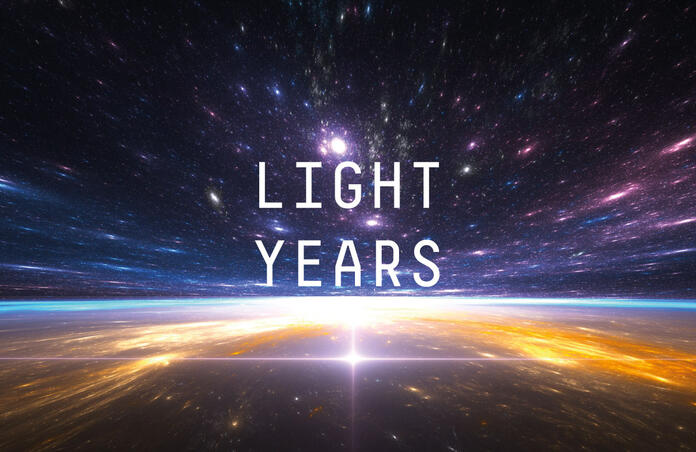What is a light-year?

You might have heard an expression saying that looking far into the Universe is looking far back in time. And there’s also something about E = mc2, right? Let’s organize this knowledge !
The first extremely important fact that we need to wrap our head around is that the speed of light in vacuum is a constant, 299 792 458 metres per second. Classically, if you walk in the same direction as the moving train you stand in, your speed with respect to the ground will be the speed of the train plus the speed of your walking – this is what Newtonian Mechanics tells us. However, if you use a laser pointer in that same train, its light will be observed to move at the speed of light c by any observer, in any “reference frame”. Einstein’s theory of special relativity explains that all massless particles (including light’s photons) and waves travel at the speed of light; it’s also where E = mc2 comes from, but this constant is also required in a variety of other equations.
Now, what does this have to do with light-years? Well, a light-year is actually a measure of distance rather than time as the name would suggest. So, we have a distance and a speed; since speed = distance/time , a light-year is the distance that a particle travelled at the speed of light in one Julian year (365.25 days). As you can imagine, it’s a very long distance, in a more familiar unit it amounts to 9.46 x 1012 km, i.e. 9 followed by 12 zeros. Another unit that astronomers commonly use is the parsec, which is an ever longer distance, 3.26 light-years.
A consequence of the above equations is also that light doesn’t reach us instantaneously from celestial objects: even for the Moon there is a 1.3 seconds “delay”, and for the Sun it’s already 8 minutes. Think about distant galaxies which are thousands, millions or even billions of light-years away: the light had to travel all this way to Earth. In the image below is the farthest object ever detected, 13.1 billion light years away, which actually means we observe an object soon after the Big Bang!
Of course, this also means that when you observe something, you’re looking at its state in the past. For example, if you observe a star a thousand light-years away, it might be in its supernova phase just now but that will only be observable in a thousand years. Rigel, Betelgeuse or Antares are all expected to go into supernova “from one day to the next”, but they are hundreds of light-years away; if you could travel there you would see that the explosion already happened – and you could observe the Supernova remnant.
A funny thing to think about is that since space is expanding and if it continues to accelerate its expansion, there is light that will never reach us. In fact, as time passes, we are able to see less and less of the Universe…
Don’t wait for that to happen! Quickly submit a One-Click Observation or view your target with an Advanced Request!
Cover Image:
Pitris / Getty Images/iStockphoto
Images credits:
Gemini Observatory/NSF/AURA/D Fox/A Cucchiara/Penn State U/E Berger/Harvard U
